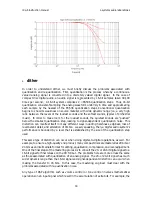
rdq-6 instruction manual
z-systems audio laboratories
20
the truncated sine wave. Observe that there are harmonically related features all up and
down the spectrum. When we listen to this signal, it will sound harsh and “buzzy,” like a
square wave. This makes sense intuitively: -96 dB undithered from full scale leaves us with
essentially two quantization steps, which looks like a very low-level square wave. Now,
suppose that before truncating to 16 bits we add a random noise signal (the dither) to the 40-
bit sine wave where the noise has a peak magnitude of approximately –84 dB from full scale.
This has the effect of “stimulating” more quantization levels. The result is the spectrum shown
in Figure 22. Observe that the harmonic distortion evident in Figure 21 is no longer present.
F
IGURE
21
It is important to understand that we haven’t gotten something for nothing. We’ve traded
harmonic distortion for an elevated noise floor. In Figure 21, the non-harmonic components
are, for the most part, below –140 dB in magnitude. In Figure 22, we can see that the noise
level has risen to roughly –125 dB. This will be perceived as a very slight hissing sound, much
like analog tape noise. This hissing, however, is much more benign than the harmonic
distortion induced by truncation. Upon listening, the signal in Figure 21 is not recognizable
as a sine wave. The signal in Figure 22, however, sounds like a sine wave in a low-level hissing
background. The same can be said for other low-level signals, not just laboratory-produced
sine wave test signals.
This example only showed the effect of “flat” dither, which is dither with a flat power
spectrum. There are other types of dither that have different shaped power spectra. For
example, it is possible to “frequency-shape” the dither so that most of its power is contained
in the high frequencies where the ear is less sensitive to it. There are also other dithers that
have more complicated spectral shapes. Whatever the flavor of dither used, its purpose is the
same: to reduce the distortions incurred whenever a signal needs to have its number of bits
reduced.
This brings us back to the discussion of digital volume control. How is it possible, then, for the
rdq-6 to control the volume in the digital domain without any significant loss of resolution?
The answer has to do with dither. Suppose you are playing a 16-bit CD through the rdq-6 and
into a 20-bit DAC. With the volume set to 0.0 dB, the 16 bits of the CD are aligned with the 16












































